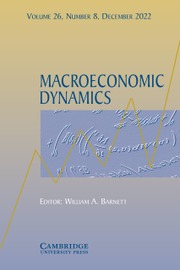Article contents
ENDOGENOUS GROWTH AND STRUCTURAL CHANGE THROUGH VERTICAL AND HORIZONTAL INNOVATIONS
Published online by Cambridge University Press: 10 August 2017
Abstract
This paper combines horizontal and vertical innovations to generate an endogenous growth model allowing for structural change as an endogenous phenomenon. Older technologies are continuously replaced by newer ones due to creative destruction, and new technologies appear as a result of horizontal innovations and due to the consumers' preference for variety. We assume fixed operational costs for the manufacturing sector and an endogenously defined patent price for every new technology. Every industry is profitable only for a limited period of time, making the effective time of existence of the technology endogenous and finite. We find that in such an economy endogenous structural change is the source of ongoing economic growth. Furthermore, the range of existing sectors as well as growth rates stays constant as long as the technologies are symmetric.
Keywords
Information
- Type
- Articles
- Information
- Copyright
- Copyright © Cambridge University Press 2017
Footnotes
We thank two referees for comments on an ealier version that helped to improve the paper. Financial support from the Bundesministerium für Bildung und Forschung (BMBF) is gratefully acknowledged (grant 01LA1105C). This research is part of the project ‘Climate Policy and the Growth Pattern of Nations (CliPoN)’.
References
REFERENCES
- 13
- Cited by

